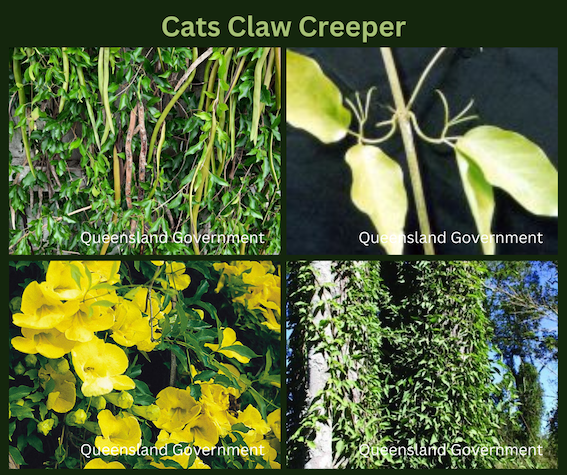Cats claw creeper is a priority weed for Upper Tingalpa Creekcare, a partnership between B4C and Seqwater. This vine is tough, fast-growing, and can outcompete riparian tree species. Cats claw causes degradation of waterways in Southeast Queensland, including extensive stretches as far as Rathdownie, and is highly invasive in the northwest suburbs of Brisbane. The concerning news is that cats claw is also spreading to urban and coastal creeks and waterways.
The latest information from the Smithsonian Institute reveals that both cats claw and its partner in crime, madeira vine are impeding the carbon capture of rainforests, thereby reducing our natural resilience against climate change. It is unfortunate news, but it is essential for us to be aware of it.
Through Upper Tingalpa Creekcare, B4C is tackling this issue head-on. Currently, we are working across ten properties to treat cats claw infestations. This includes a significant project in the Rochedale “Cluster” along Priest Gully, which flows into Leslie Harrison Dam. After three months of dedicated work, the initial treatment is almost complete, with a follow-up treatment scheduled to begin in January 2024.
Recognising the urgency of the situation, it is important to be able to identify both cats claw creeper and madeira vine. Both these species are category 3 restricted invasive plants under the Biosecurity Act 2014.
How do you identify cats claw creeper?
- Each leaf of the cats claw creeper has two leaflets with a three-clawed tendril growing between them
- The plant produces large, bright yellow, bell-shaped flowers in spring
- Seed capsules are long, narrow, and flat, containing many papery seeds
- Seed pods are glossy green when young and darken to brown as they mature.
How do you identify madeira vine?
- Madeira vine has fleshy, waxy green, heart-shaped leaves that are typically 4-5 cm in length
- Slender and hairless stems that start as herbaceous but become woody as they age
- Clusters of aerial tubers along the stem, ranging from 5 mm to 25 cm in size. These tubers are light brown or green and have a “warty” appearance
- Subterranean tubers resembling potatoes, which can grow up to 20 cm in diameter and are found at depths of up to 1 m
- Dense blankets of creamy flower spikes from December to April. These spikes are approximately 10 cm long and consist of numerous small flowers along a drooping central stem.
Treating both cats claw creeper and madeira vine are a top priorities for Upper Tingalpa Creekcare. If you live in the Upper Tingalpa Creek Catchment (see map), you can contact Wayne Cameron at B4C for on-the-ground support in addressing these invasive vines on your property.
For those outside the Upper Tingalpa Creek Catchment, please report any sightings of cats claw to your local council. You can report cats claw to Brisbane City Council using the following link: https://weeds.brisbane.qld.gov.au/report
Together, we can protect our waterways and trees from the threat of cats claw creeper and madeira vine.








